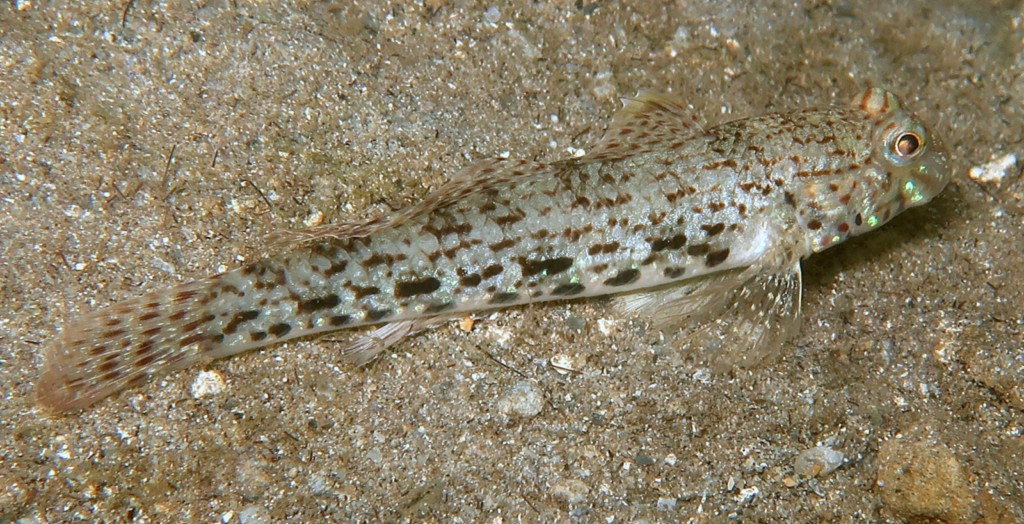ISTIGOBIUS ORNATUS - (RUPPELL, 1830)
Picture courtesy of: Alain Daoulas
Actinopterygii (Gigaclass) > Actinopteri (Class) > Teleostei (Subclass) > Gobiiformes (Order) > Gobioidei (Suborder) > Gobiidae (Family) > Gobiinae (Subfamily) > Istigobius (Genus)
Gobie orné, Ornate goby, Ornate sand goby, Korutokko, Kazarihaze, カザリハゼ, 妆饰细棘鰕虎鱼, 飾銜鯊, Cá Bống chấm hoa,
Synonymes
Acentrogobius ornatus (Rüppell, 1830)
Ctenogobius calderae (Evermann & Seale, 1906)
Gobius calderae (Evermann & Seale, 1906)
Gobius ehrenbergii (Valenciennes, 1837)
Gobius elegans (Valenciennes, 1837)
Gobius interstinctus (Richardson, 1844)
Gobius ornatus (Rüppell, 1830)
Gobius ornatus (Day, 1871)
Gobius periophthalmoides (Bleeker, 1851)
Gobius stephensoni (Whitley, 1932)
Gobius thurstoni (Day, 1888)
Gobius ventralis (Valenciennes, 1837)
Gobius venustulus (Fowler, 1904)
Istigobius elegans (Valenciennes, 1837)
Istigobius stephensoni (Whitley, 1932)
Rhinogobius calderae (Evermann & Seale, 1906)
------------------------
Description
Dorsal spines (total): 7, 4th spine of first dorsal fin longest; Dorsal soft rays (total): 10-12; Anal spine: 1; Anal soft rays: 9-11: Pectoral fins rays: 16-20, and 3-4 upper rays free from membrane; Lateral scale series: 29-32; Transverse rows of scales backwards: 7½-9; Predorsal scales cycloid: 9-12, trunk ctenoid. Mouth with overhanging snout, lips greatly thickened. No large recurved tooth at each side of lower jaw. Cheeks and operculae without scales. Eyes situated dorso-laterally; Reduced swim bladders. Max. length: 11.0 cm TL. Depth range: 0 - 5 m, usually: 0 - 2 m.
Color
Head and body yellowish to pale brown, with black, yellow, blue and red markings; Double row of blackish spots along sides most conspicuous, and lower row shorter; Fins finely striped or spotted with red-brown, yellow and blue. Female pelvic and anal fins not as darkly pigmented as in male.
Etymology
Istigobius: from Greek, istios = sail + from Latin, Gobius = a genus name of gobiine fish. Proposed as a subgenus of Gobius, referring to “larger scales, and longer caudal peduncle” of Istigobius stephensoni (now: Istigobius ornatus) compared to “true Palearctic” Gobius.
ornatus: from Latin, orno = adorned, decorated. Referring to its beautiful body color.
Original description: Gobius ornatus Rüppell, 1830 - Locality type: Massawa, Eritrea, Red Sea.
Distribution
Red Sea and Indo-West Pacific: East Africa, Persian Gulf, Socotra (Yemen), Seychelles, Comoros, Madagascar and Mascarenes (Mauritius), east to Society Islands and Marquesas Islands (French Polynesia), north to southern Japan and Ogasawara Islands (Japan), south to Queensland (Australia), New Caledonia and Tonga.
Biology
A common species that inhabits mangroves and silty, rocky areas; Occasionally found in rubble reef areas. Only single individuals were observed; Many individuals found scattered over a small area. Feeds on small invertebrates. Genital papilla, of male varying from lightly to heavily pigmented and terminating to side of anal spine. Female genital papilla lightly pigmented and truncate, terminating well before anal spine. Benthic spawner. Aquarium fish.
Last update: 9, October 2024
Actinopterygii (Gigaclass) > Actinopteri (Class) > Teleostei (Subclass) > Gobiiformes (Order) > Gobioidei (Suborder) > Gobiidae (Family) > Gobiinae (Subfamily) > Istigobius (Genus)
Gobie orné, Ornate goby, Ornate sand goby, Korutokko, Kazarihaze, カザリハゼ, 妆饰细棘鰕虎鱼, 飾銜鯊, Cá Bống chấm hoa,
Synonymes
Acentrogobius ornatus (Rüppell, 1830)
Ctenogobius calderae (Evermann & Seale, 1906)
Gobius calderae (Evermann & Seale, 1906)
Gobius ehrenbergii (Valenciennes, 1837)
Gobius elegans (Valenciennes, 1837)
Gobius interstinctus (Richardson, 1844)
Gobius ornatus (Rüppell, 1830)
Gobius ornatus (Day, 1871)
Gobius periophthalmoides (Bleeker, 1851)
Gobius stephensoni (Whitley, 1932)
Gobius thurstoni (Day, 1888)
Gobius ventralis (Valenciennes, 1837)
Gobius venustulus (Fowler, 1904)
Istigobius elegans (Valenciennes, 1837)
Istigobius stephensoni (Whitley, 1932)
Rhinogobius calderae (Evermann & Seale, 1906)
------------------------
Description
Dorsal spines (total): 7, 4th spine of first dorsal fin longest; Dorsal soft rays (total): 10-12; Anal spine: 1; Anal soft rays: 9-11: Pectoral fins rays: 16-20, and 3-4 upper rays free from membrane; Lateral scale series: 29-32; Transverse rows of scales backwards: 7½-9; Predorsal scales cycloid: 9-12, trunk ctenoid. Mouth with overhanging snout, lips greatly thickened. No large recurved tooth at each side of lower jaw. Cheeks and operculae without scales. Eyes situated dorso-laterally; Reduced swim bladders. Max. length: 11.0 cm TL. Depth range: 0 - 5 m, usually: 0 - 2 m.
Color
Head and body yellowish to pale brown, with black, yellow, blue and red markings; Double row of blackish spots along sides most conspicuous, and lower row shorter; Fins finely striped or spotted with red-brown, yellow and blue. Female pelvic and anal fins not as darkly pigmented as in male.
Etymology
Istigobius: from Greek, istios = sail + from Latin, Gobius = a genus name of gobiine fish. Proposed as a subgenus of Gobius, referring to “larger scales, and longer caudal peduncle” of Istigobius stephensoni (now: Istigobius ornatus) compared to “true Palearctic” Gobius.
ornatus: from Latin, orno = adorned, decorated. Referring to its beautiful body color.
Original description: Gobius ornatus Rüppell, 1830 - Locality type: Massawa, Eritrea, Red Sea.
Distribution
Red Sea and Indo-West Pacific: East Africa, Persian Gulf, Socotra (Yemen), Seychelles, Comoros, Madagascar and Mascarenes (Mauritius), east to Society Islands and Marquesas Islands (French Polynesia), north to southern Japan and Ogasawara Islands (Japan), south to Queensland (Australia), New Caledonia and Tonga.
Biology
A common species that inhabits mangroves and silty, rocky areas; Occasionally found in rubble reef areas. Only single individuals were observed; Many individuals found scattered over a small area. Feeds on small invertebrates. Genital papilla, of male varying from lightly to heavily pigmented and terminating to side of anal spine. Female genital papilla lightly pigmented and truncate, terminating well before anal spine. Benthic spawner. Aquarium fish.
Last update: 9, October 2024
